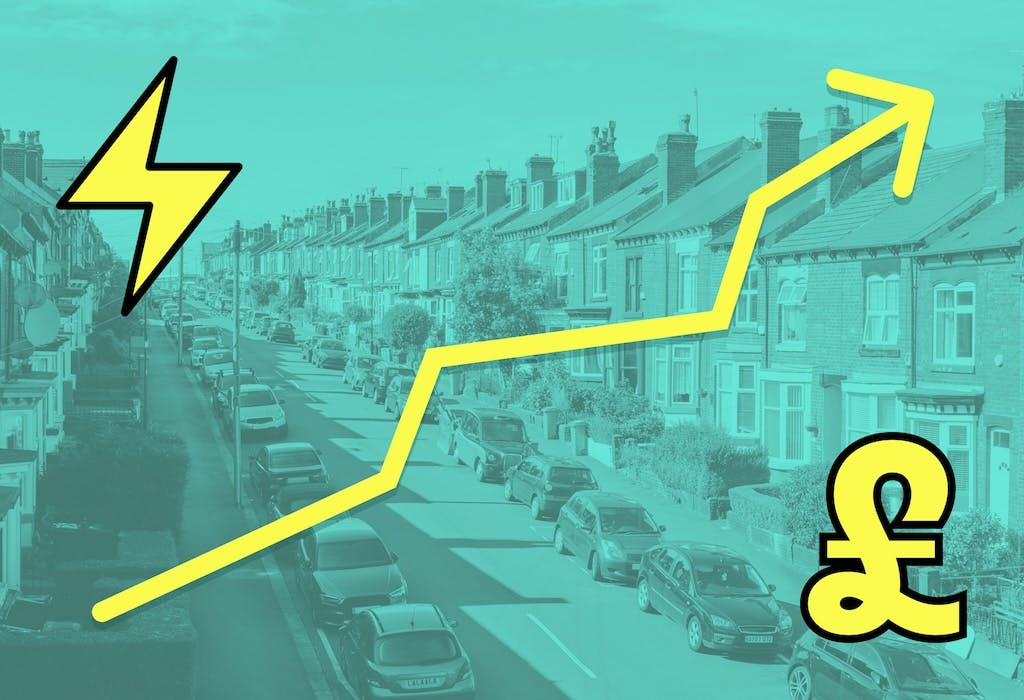Why is electricity so expensive?
Learn about why electricity costs so much in the UK, why it's much more expensive than gas, and what the future holds.
Written byMelody Abeni

Calculate savings
What kind of home do you live in?
Calculate savings
What kind of home do you live in?
The UK’s expensive electricity: at a glance
⚡ Electricity is expensive mainly due to the 'marginal cost pricing' mechanism
🏭 We use gas-fired power plants to generate some of our electricity
🍃 Energy suppliers pass the cost of green levies onto households through bills
📈 The price of electricity in the UK is projected to stay high until the 2030s
Electricity prices in the UK reached record levels during the energy crisis, triggering a nationwide reassessment of where we buy our power from.
Bills have certainly fallen since then, but they’re still well above pre-2022 levels, and experts think they’ll stay high until at least the late 2030s.
In this article, we’ll explore why electricity is so expensive, and also why it costs so much more than gas.
And if you’re looking for ways to cut your electricity bills, solar panels are a tried and tested solution in the UK. To find out how much you can save with a solar & battery system, answer a few questions below and we'll provide an estimate.
Find out how much you can save
What kind of home do you live in?
The reasons why electricity costs so much
The UK has invested a lot of money into renewable energy projects, with wind and solar now providing a substantial portion of our power, yet electricity prices are still much higher than gas prices.
Under the April 2025 energy price cap, electricity costs 27.03p per kilowatt-hour (kWh) compared to just 6.99p/kWh for gas, which is a staggering disparity.
There are two key reasons behind this imbalance, which we'll explore below.
1. The wholesale cost is usually determined by gas
The high cost of electricity in the UK is largely due to the marginal cost pricing mechanism, which sets electricity prices based on the cost of the last (and usually most expensive) energy source needed to meet demand at any given time.
The National Grid uses a mix of energy sources to meet fluctuating electricity demand throughout the day. This includes renewables, like wind and solar, but these are subject to natural conditions like dunkelfluate that limit their ability to meet demand on their own.
While renewables are prioritised upfront as the cheapest electricity sources in the energy mix, their intermittent nature means gas-fired power plants often get switched on to fill gaps when demand exceeds supply.
Gas plants are more expensive to operate, and under this system, their costs set the price for all electricity generated during a specific time window, regardless of how it was created.
In fact, a UCL research project in 2022 found that gas sets the price of electricity around 84% of the time in the UK.
And since the UK imports around 70% of its gas, global crises and geopolitical events (like the 2022 energy crisis) can make prices jump even further.
The wholesale cost of electricity makes up about one third of the price of electricity in 2025, hence why changes in the wholesale cost have such a large impact on what we pay.
Why does the UK have this mechanism?
Marginal cost pricing isn't unique to the UK, or even to the supply of electricity. It’s a standard system used in many commodity markets (like oil, wheat, and metals) to balance supply and demand efficiently.
In the UK energy market, this mechanism ensures that the cheapest sources of electricity are used first, while the most expensive sources are deprioritised. The idea is that the fossil fuel plants are used as sparingly as possible, i.e. only when they’re needed to make up the shortfall.
It also means that producers of renewably-generated electricity can make a much larger profit, recover their upfront installation costs, and reinvest this money for further green projects.
However, this system has significant downsides.
As expensive imported gas is often the marginal source, electricity prices get intertwined with fluctuating gas markets. So, even though renewable electricity is cheaper to produce, these cost savings aren’t passed on to consumers - instead, the mechanism leaves us with persistently high bills.

Do other countries have this mechanism?
Many countries use marginal cost pricing for their electricity markets.
The European Union applies this system widely through its internal energy market as the 'merit order' model , however this system has faced similar criticisms to the UK for tying electricity prices to volatile global gas markets during energy crises.
Some parts of the US and Canada also use marginal pricing.
In the US, some wholesale electricity markets like the California Independent System Operator (CAISO) and the Independent System Operator (ISO) for New England follow a location-based version , while the Canadian province of Alberta uses a similar system.
2. Green levies and generation subsidies
The second major factor contributing to high electricity prices in the UK is the cost of green levies, or 'Environmental and social obligation costs' as Ofgem calls them.
Energy suppliers pass these costs on to you through your bills to fund green energy projects, efficiency upgrades, and financial support for those in need.
According to Ofgem's 2021 breakdown of energy bills, these levies accounted for just over 25% of the cost of electricity, but less than 3% of the cost of gas.
Let's take a more detailed look at what these levies fund.
The Renewables Obligation
The UK government introduced the Renewables Obligation (RO) in 2002 as the country's first major renewable energy subsidy.
The RO required energy suppliers to buy Renewables Obligation Certificates (ROCs) from renewable generators, and suppliers then passed these costs on to consumers.
According to Nesta, the scheme raises around £3 billion each year, adding 3.2p per unit of electricity and £86 to the average dual-fuel household bill. This makes it the largest policy cost on electricity bills.
Although the RO closed to new projects in 2017 as renewables became cheaper, we will continue paying for existing contracts in our bills until 2037, with costs beginning to taper off from 2027.
It has since been replaced by the more cost-effective Contracts for Difference (CfDs) scheme, which we'll cover below.
The Feed-in Tariff
The Feed-in Tariff (FiT), introduced in 2010, incentivised small-scale renewable energy generation, such as solar panels and wind turbines.
The FiT paid households and businesses for every unit of electricity they generated, even if they used it themselves, as well as extra payments for exporting surplus energy to the grid.
The scheme proved very popular, guaranteeing payments for 20-25 years, but it closed to new applicants in 2019. Since then, the Smart Export Guarantee (SEG) - which is paid for by suppliers, rather than consumers - has become a lucrative way for solar households to earn export income.
FiT funding adds £689 million per year to electricity bills at a rate of 0.7p per unit, as calculated by Nesta. Payments will continue for existing projects until the early 2040s, gradually tapering off as contracts expire.

Contracts for Difference
Introduced in 2014, Contracts for Difference (CfDs) are the UK's main way of incentivizing low carbon energy generation - and have so far supported 39 gigawatts (GW) of low-carbon energy projects.
Under CfDs, renewable energy producers are guaranteed a fixed 'strike price' for the electricity they generate.
If market rates fall below this strike price, the government pays the difference to the producer. But if market rates exceed the strike price, producers pay the surplus back to the government, which helps reduce costs for consumers.
While CfDs add £1.8 billion annually to our electricity bills , they are intended to help stabilise prices by reducing our reliance on volatile fossil fuels.
The Capacity Market
The Capacity Market is a government scheme that ensures the UK has enough electricity supply to meet demand during peak times or when renewable generation is low.
The scheme pays energy providers, including fossil fuel plants, to guarantee they can deliver electricity when needed. It adds £1 billion to our electricity bills each year, but helps keep prices steady in the long run, according to Nesta.
While the Capacity Market helps prevent blackouts and supports grid reliability, its costs are mounting and they may be at least double by 2028.
The "spark gap" in other countries
The "spark gap" refers to the difference between the unit cost of electricity and the unit cost of gas. The size of this gap varies considerably between countries, depending on their policies, tax systems, and various energy sources.
Recent figures from the UK's Department for Energy Security and Net Zero (DESNZ) show how prominent the spark gap is in European countries like Belgium, Germany, and Ireland , where electricity prices are among the highest in the EU because of taxes, levies, and renewable subsidies.
Spain and Portugal also have significant spark gaps, though reforms in 2023 aimed to reduce electricity costs. France, comparatively, has a smaller spark gap due to its reliance on nuclear power, which helps keep electricity prices relatively low.
The spark gap is less pronounced in countries like the US and Canada, which generally have lower electricity prices due to abundant natural resources and less reliance on imported energy.
Looking ahead
The price of electricity in the UK is high due to our marginal cost pricing mechanism, the hefty cost of natural gas, and the great expense of moving to cleaner energy. It's also projected to remain expensive until the late 2030s, according to Cornwall Insight.
By 2050, the UK is expected to be using more than double the electricity it uses now to support the transition to a greener economy , with the push for more electric vehicles, heat pumps, and other low-carbon technologies.
Now is certainly a good time to explore ways to reduce your reliance on the grid. A solar & battery system can help you take control of your energy costs and protect yourself from rising bills, as well as contribute to a greener future.
Curious about how much you could save with a solar & battery system? Answer a few quick questions below to get an estimate.
Find out how much you can save
What kind of home do you live in?
FAQs
Why am I paying so much for electricity?
The price of electricity in the UK is so high because it’s set by the cost of the last (and usually most expensive) energy source needed to meet demand at any given time - which is almost always gas.
And with the UK importing around 70% of its gas, global price spikes directly impact bills.
Plus, environmental levies and grid maintenance costs are included in electricity bills, further increasing costs.
Are UK electricity prices the highest in the world?
UK electricity prices are among the highest in the world, for both households and industries.
According to the BBC, our domestic electricity prices were the fourth highest in Europe in the first half of 2024 , while our industrial electricity costs were the highest in the world, at 29.6p per kWh.
Is gas cheaper than electricity?
In the UK, gas is significantly cheaper than electricity.
Under the April 2025 energy price cap, the unit rate for gas is just 6.99p/kWh, whereas it’s 27.03p/kWh for electricity.
This discrepancy is known as the ‘spark gap’, and there is a pretty significant spark gap in many European countries - not just the UK.

Written byMelody Abeni
Based in London, Melody is a specialist green technology writer who has been covering sustainability, climate action and ESG for the past five years, after gathering operational experience in green investing and financial services. She has written for various industry publications, including renewable technology advisor The Eco Experts, and she holds a Master’s degree in law from Birkbeck University.